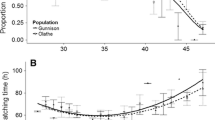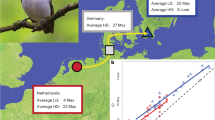Abstract
These studies were desgned to detect geographic variation in emigration behavior, at various temperatures, of newly collected wild strains ofDrosophila melanogaster. Natural populations from various geographic regions showed three basic emigration response patterns to temperature: linear, threshold, and optimum-temperature response types. The emigration activity of northern mainland populations increased in the range of 15–20°C, whereas the activity of comparable southern populations increased linearly with increasing temperatures. The northern island populations showed the optimum-temperature response type, and the comparable southern island populations showed all three emigration patterns. In most cases emigration activity on islands was generally reduced compared with that on the adjacent mainland. The northern island populations, however, showed a higher emigration activity at 25°C than the adjacent mainland populations. Here the different sensitivities to temperature seemed to be related to differences in both climatic conditions and insular conditions.
Similar content being viewed by others
References
Dobzhansky, T., and Wright, S. (1943). Genetics of natural populations. X. Dispersion rates inDrosophila pseudooscura.Genetics 28: 304–340.
Dobzhansky, T., Powell, J. R., Taylor, C. E., and Andregg, M. (1979). Ecological variables affecting the dispersal behavior ofDrosophila pseudoobscura and its relatives.Am. Nat. 114:325–334.
Dubinin, N. P., and Tiniakov, G. G. (1946). Inversion gradients and natural selection in ecological races ofDrosophila funebris.Genetics 31:537–545.
Dyson-Hudson, V. R. D. (1956). The daily activity rhythm ofDrosophila subobscura andD. obscura.Ecology 37:562–567.
Johnston, J. S., and Heed, W. B. (1976). Dispersal of desert-adaptedDrosophila: The saguaro-breedingD. nigrospiracula.Am. Nat. 110:629–651.
Kramer, G. (1951). Body proportions of mainland and island lizards.Evolution 5:193–206.
Mayr, E. (1963).Animal Species and Evolution, Harvard University Press, Cambridge, Mass.
Mikasa, K., and Narise, T. (1979). The relation between dispersive behavior and temperature inDrosophila melanogaster. I. Dispersal patterns.Jap. J. Genet. 54:217–228.
Powell, J. R., Dobzhansky, T., Hook, J. E., and Wistrand, H. (1976). Genetics of natural populations. XLIII. Further studies on rates of dispersal ofDrosophila pseudoobscura and its relative.Genetics 82:493–506.
Rockwell, R. F., Grossfield, J., and Levine, L. (1978). Emigration behavior. I. Effects of height and light on the Oregon-R and norp-A strains ofDrosophila melanogaster.Egypt. J. Genet. Cytol. 7:123–136.
Sakai, K., Narise, T., Hiraizumi, Y., and Iyama, S. (1958). Studies on competition in plants and animals. IX. Experimental studies on migration inDrosophila melanogaster.Evolution 12:93–101.
Sullivan, T. P. (1977). Demography and dispersal in island and mainland populations of the deer mouse,Peromyscus maniculatus.Ecology 58:964–978.
Tamarin, R. (1977). Dispersal in island and mainland voles.Ecology 58:1044–1054.
Tamarin, R. (1978). Dispersal, population, and K-selection in field mice.Am. Nat. 112:545–555.
Tantawy, A. O., Mourad, A. M., and Abou-Youssef, A. A. (1975). Studies on natural populations ofDrosophila. XVI. Migration inDrosophila melanogaster in relation to genotype, temperature and population density.Egypt. J. Genet. Cytol. 4:263–276.
Author information
Authors and Affiliations
Rights and permissions
About this article
Cite this article
Mikasa, K., Narise, T. Interactive effects of temperature and geography on emigration behavior ofDrosophila melanogaster: Climatic and island factors. Behav Genet 13, 29–41 (1983). https://doi.org/10.1007/BF01071742
Received:
Accepted:
Issue Date:
DOI: https://doi.org/10.1007/BF01071742




